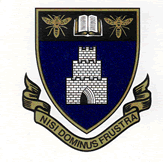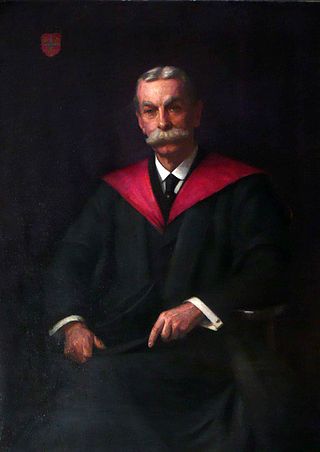
Samuel Parr, was an English schoolmaster, writer, minister and Doctor of Law. He was known in his time for political writing, and (flatteringly) as "the Whig Johnson", though his reputation has lasted less well than Samuel Johnson's, and the resemblances were at a superficial level; Parr was no prose stylist, even if he was an influential literary figure. A prolific correspondent, he kept up with many of his pupils, and involved himself widely in intellectual and political life.

Samuel Harsnett, born Samuel Halsnoth, was an English writer on religion and Archbishop of York from 1629.

The Royal Grammar School Worcester is an eleven-eighteen co-educational, private day school and sixth form in Worcester, Worcestershire, England. Founded before 1291, it is one of the oldest British independent day schools.

Knox Grammar School is an independent Uniting Church day and boarding school for boys, located in Wahroonga, New South Wales, an Upper North Shore suburb of Sydney, Australia. Founded in 1924 by the Presbyterian Church of Australia as an all-boys school, and named after John Knox. The school has since grown, branching out into a large Senior School and a Preparatory School, enrolling approximately 2900 students. The school also caters for approximately 160 boarding students from Years 7 to 12.

The Royal Grammar School, High Wycombe, is a selective boys' grammar school situated in High Wycombe, Buckinghamshire, England. As a state school, it does not charge fees for pupils to attend, but they must pass the 11 plus, an exam that some primary schools administer. In February 2011, the school became an Academy.

Colchester Royal Grammar School (CRGS) is a state-funded grammar school in Colchester, Essex. It was founded in 1128 and was later granted two royal charters - by Henry VIII in 1539 and by Elizabeth I in 1584.

The Royal Grammar School, Guildford, also known as the RGS, is a private selective day school for boys in Guildford, Surrey in England. The school dates its founding to the death of Robert Beckingham in 1509 who left provision in his will to 'make a free scole at the Towne of Guldford'; in 1512 a governing body was set up to form the school. The school moved to the present site in the upper High Street after the granting of a royal charter from King Edward VI in 1552. Around that time, its pupils were playing cricket and their activity was later documented as the earliest definite reference to the sport. The school's Old Building, constructed between 1557 and 1586, is the home of a rare example of a chained library. It was established on the death of John Parkhurst, Bishop of Norwich, in 1575. Although defined as a 'free' school, the first statutes of governance, approved in 1608, saw the introduction of school fees, at the rate of 4 shillings per annum, along with the school's first admissions test. During the late 19th century the school ran into financial difficulty, which nearly resulted in its closure. A number of rescue options were explored, including amalgamation with Archbishop Abbott's School. Funds were eventually raised, however, which allowed the school to remain open, although boarding was no longer offered.

Reigate Grammar School is a 2–18 co-educational private day school in Reigate, Surrey, England. It was established in 1675 by Henry Smith.

The Headmasters' and Headmistresses' Conference (HMC), formerly known as the Headmasters' Conference and now branded HMC (The Heads' Conference), is an association of the head teachers of 351 private fee-charging schools (both boarding schools and day schools), some traditionally described as public schools. 302 members are based in the United Kingdom, Crown dependencies and the Republic of Ireland. There are 49 international members (mostly from the Commonwealth) and also 28 associate or affiliate members who are head teachers of state schools or other influential individuals in the world of education, who endorse and support the work of HMC.

The Skinners' School, is a British Grammar School with academy status for boys located in the town of Royal Tunbridge Wells, Kent, England. Established in 1887, the school was founded by the Worshipful Company of Skinners in response to a demand for education in the region. Today Skinners' remains an all-boys grammar school, recently awarded specialist status in science and mathematics in recognition of these disciplines' excellent teaching. The current enrolment is 1119 pupils, of whom around 326 are in the sixth form. The first headmaster was Reverend Frederick Knott, after whom Knott House is named. The current Headmaster is Edward Wesson.

Launceston Church Grammar School is an Anglican co-educational private school in Launceston, Tasmania, Australia for Early Learning through to Grade 12.

Borden Grammar School is a grammar school with academy status in Sittingbourne, Kent, England, which educates boys aged 11–18. A small number of girls have also been admitted to the Sixth Form. The school holds specialist status in sports.

Dunstable Grammar School was a grammar school in the market town of Dunstable, Bedfordshire, England. Opened in 1888, it was closed in 1971.
The Gilberd School is a coeducational secondary school with academy status, in Colchester, Essex, England.

Dedham is a village in the City of Colchester district of Essex, England. It is near the River Stour, which is the border of Essex and Suffolk. The nearest town to Dedham is the small market town of Manningtree.
Earls Colne Grammar School was a grammar school in Earls Colne, Essex, England that was founded in 1520 and closed in 1975.
Retford Oaks Academy is a coeducational secondary school and sixth form located in the market town of Retford, Nottinghamshire, England, situated in the district of Bassetlaw.

Percy Shaw Jeffrey FRGS was a respected English schoolmaster and author of several books on a range of topics, including significant contributions towards the teaching of phonetics in schools. Shaw Jeffrey taught at a variety of schools before spending sixteen years as headmaster at Colchester Royal Grammar School. With his wife, Alice, he retired first to South Africa, then to the town of Whitby, North Yorkshire, in 1916, where he spent his time between numerous trips to countries around the world.
William Dugard, or Du Gard, was an English schoolmaster and printer. During the English Interregnum, he printed many important documents and propaganda, first in support of Charles I and later of Oliver Cromwell. He also proved a successful master at a number of schools, including the Merchant Taylor's School, Colchester Royal Grammar School and Stamford School, and wrote a number of non-fiction works.














